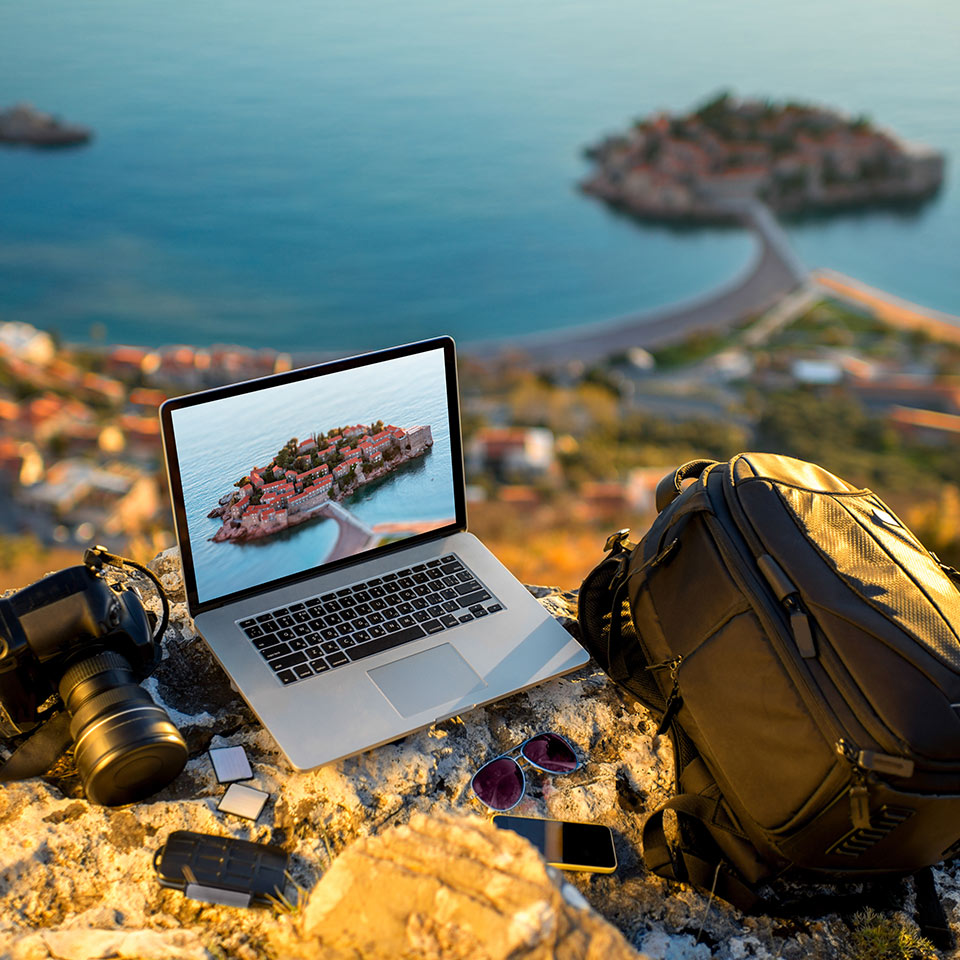When you’re on your travels, have you ever stopped to think that your experience would make for a fascinating story? If so, then you were actually considering travel writing.

Jump to:
Travel writing can transport the reader to new and exciting places. When done well, it can inspire others to explore and experience new things and garner an appreciation for different cultures. However, putting your travel experiences on paper can be extremely difficult.
With so many people travelling, travel writing is becoming more and more popular. However, doing travel writing well can be challenging. After all, a place is so many things; it’s the people, the architecture, the vibrant and unique sounds and, of course, the delicious food. Encapsulating all of these experiences into a single piece of writing is never easy. You can’t simply do a play-by-play. Doing this would make your writing sound like you are going through a checklist of your itinerary, and it won’t make for interesting reading.
If you have been contemplating travel writing but don’t know where to start, then we have got you covered. Before you embark on your journey to become the next Paul Theroux or Bruce Chatwin, join us as we detail some helpful tips for travel writing.
Recommended for you!
Best SellersWhat Is Travel Writing?
Before delving into ways to improve your travel writing, it’s worth defining what travel writing actually is. Simply put, travel writing is a genre of writing that involves documenting the experiences, observations, and reflections of an author during their travels.
The writing revolves around visiting places and observing things that are unique to the specific destination, like the landscape and geography, the people and their customs (such as the history, culture, and food). There are many different types of travel writing. Understanding the form your writing best fits is the key to writing an exceptional travel piece.
Travel Writing Examples
- Articles
- Essays
- Books
- Blogs
- Travel Guides
- Travel Journalism
- Itineraries
Once you understand which form of travel writing best suits you and the structure of your writing, it is time to start writing.

Have Goal In Mind
If you don’t have a clear goal, you will quickly find that your writing will falter and become incoherent or uninteresting. Before putting pen to paper, just think: what is the point of your story, and what are you trying to convey?
It is important to remember that a trip is not a story in itself. Your writing has to have meaning and purpose. Recalling your journey through the Atlas Mountains may sound interesting to you, but it may not sound so interesting to the reader. This is where you have to consider the message of what you are trying to convey. Are you trying to encourage them to embark on their adventure through the mountains or are you trying to purely illustrate the beauty of the experience?
Before starting, you should always consider the purpose of your writing. You may also wish to produce a rough outline for the narrative of your story. This will help you to write more freely without fear of running into the dreaded writer’s block.
Know The General Rules of Travel Writing
Different types of writing have their own conventions. Think about guides and how they are written formally in the third person. While you don’t have to stick to the rules and conventions of the genre to the point when it hinders you as a writer, utilising the genre’s conventions can help to make your writing more digestible to your audience, resulting in an easier reading experience. Some of the common conventions of travel writing include:
- Write in the past tense
- Write in first-person (after all, it’s your story!)
- Contain sensory details
- Be conventional in tone; don’t go over the top with experimenting
- Ensure your writing is accessible, and pay particular attention to readability
- Provide value to the reader in some way
Read Other High-Quality Travel Writing
Reading other pieces of travel literature can be extremely helpful when it comes to honing your travel writing skills.
Reading well-established, high-quality pieces of writing can better instruct you on how to produce your own writing. Not only does it help to inspire your writing, but it can be extremely useful to see how others approach the task of describing their travels. You may even find yourself incorporating elements of other writers' work into your own.
Reading other pieces of travel writing is a fantastic way to expand your knowledge of the genre and help you understand what works best for you and your writing style.
Be Selective With What You Include
It may sound obvious, but not everything from your trip needs to be included in your work. While including little offhand occurrences and amusing scenarios helps to flesh out your story, there will be a vast amount of events you should omit. For example, your transfer to and from the airport or how you decided which outfit you would wear on a specific day probably don’t need to make the cut. While these occasions may seem important to you, they should usually be omitted from your work.
Omitting surplus events helps to make your story coherent and tighter, making it more enjoyable to read and keeping your audience engaged for longer.
Write A Killer Intro
Introductions are important regardless of the form of writing. If you don’t get off to a good start, the reader may not wish to read on. You need to grab their attention by any means necessary, whether that means utilising drama, humour, dialogue or a combination of the three. This is why many travel writers start their work with an amusing anecdote that introduces the general feeling, tone and point of the story.
You may wish to start your writing with a question, whether it be psychological, comical or rhetorical. The question’s main aim is to engage the reader and get them thinking.
Another common way to start a piece of travel writing is to start in media res, which means in the ‘middle of things’. This is similar to how films choose to start halfway through the narrative during a climactic or pivotal event but then backtrack to the beginning story to show how they ended up in such a scenario. An example of this would be if you started your writing by detailing your experience zip-lining hundreds of feet in the air in Jebel Jais. This works as a hook, immediately engaging the reader and encouraging them to read on to discover how you ended up in such a situation.

Try to Avoid Cliches
One of the most common mistakes in travel writing is cliches. It is so easy to fall into the trap of writing things in a cliche way. Try to avoid phrases such as bustling markets, green grass or ‘a smorgasbord of’ declaration. Using these terms can come across as corny, stereotypical or boring. Travel writing is all about your own unique experiences, so you should never feel the need to lean into other commonly used terms or phrases.
Try to come up with phrases to describe things which are unique to your situations and experiences. So instead of using the term ‘bustling markets’ to describe a lively local market, why not use a more tailored phrase which better suits your situation, such as ‘ the colourful and madcap market’ or ‘the traditional and inexpensive market’? These terms are just a little bit more specific and will help to paint a better picture of your experiences to the audience.
Don’t Be Afraid of Dialogue
There is an extremely high probability that, on your travels, you will have had a conversation with someone. Unless you travelled to a Buddhist temple to visit monks who swore a vow of silence (and even if you did, you’ll probably have had a conversation with someone in the vicinity!), you’ll have spoken to someone. So, why wouldn’t your writing have dialogue in it?
Including dialogue in your travel writing helps to entertain your audience as well as engage them in the world of your travels. Dialogue brings a scene to life, gives personality to the people who occupy your story, and allows you to convey important information in a punchy and digestible way.
You don’t have to include every bit of dialogue you experienced on your trip. For example, if you went to a restaurant, you don’t have to include the waiter taking your order, or when checking into your accommodation you wouldn’t have to include a concierge telling you your room number. The only time you’d want to include this kind of dialogue would be if there was an amusing anecdote attached. The dialogue in your story should help to enhance and develop it.

Don’t Be Afraid to Redraft and Edit
They say practice makes perfect.
Sometimes, you may need to redraft a piece of work multiple times before you are happy with it. On other occasions, you might be able to do it right the first time. The most important thing is to ensure your edits and redrafts are done organically, aiding the development and quality of your work and never hindering it.
Redrafting doesn’t have to be solely your job. You may want to get an extra pair of eyes by asking someone you trust to proofread. If you want your work to be the best it can be, then you shouldn’t be afraid of editing and redrafting.
Maintain Continuity
Having continuity in your writing is always important. If your writing lacks an element of consistency (e.g. in one paragraph you said that you ordered the chef’s special with a glass of white wine, but in the next paragraph you say you are drinking red wine, or you said that there were 5 people present at an event, but in the next breath there are only 4) the reader may not have total faith in your narrative. You must ensure that your story is aligned and absent of plotholes and continuity errors.
However, continuity in travel writing is more than just making sure that your recollections of certain events hold up to analytical scrutiny. You need to uphold continuity in the themes of your writing as well. If the main goal of your narrative is to establish why someone should visit a certain location, then you should never shift focus away from this.
Learn More About Travel Writing with Centre of Excellence
Interested in learning more about travel writing or want to hone and expand your travel writing skills? Why not enrol in one of our travel diploma courses? We cover how to establish a Travel Writing Business and how to run a Travel Blog, and also have more general Travel and Tourism Diplomas available. Furthermore, all of these courses are now available for the discounted price of £29 (instead of the original £127).
There’s also the option of Grow: our subscription service. With Grow Yearly, just £192 per year (i.e. £16 per month) will get you full access to one of our travel writing courses plus 11 other courses from our wider library, as well as 12 audio courses! Grow also comes with an in-built 10% reduction on printed materials and certificates, plus exclusive discounts and reward points that you can redeem for fantastic prizes.
So what are you waiting for? Jumpstart your career in travel writing today!













